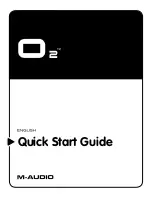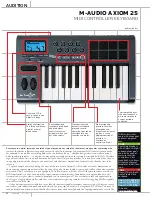
Duration Group Associated Parameters
915
notes, any step in the Duration Pattern (as modified by
the Duration Value) that is shorter than a quarter note
will cause the notes (and all sustaining notes at that
time) to have the specified duration. This is useful for
simulating the technique of strumming and damping
certain chords within the progression. Any value in a
Duration Pattern step (as modified by the Duration
Value) that is longer than the current Rhythm Pattern
value will be ignored, and the notes will sustain as
described above. The “Duration Value” specifies a
percentage of the overall value (1 – 800%) - therefore,
values less than 100% will shorten the duration
represented by the Pattern Step, and values greater
than 100% will lengthen it.
1: Poly Extend/Damped
The same as above, except all sustaining notes will be
damped when the chord changes, not just notes that
are no longer in the Note Series.
2: Mono Extend
The same as above, except each note or cluster is
sustained until the next note or cluster (of any pitch or
pitches) is generated.
3: Timed
(“Duration Value”: 1…5000 ms)
The “Duration Value” parameter is used to specify the
duration of the generated notes, in milliseconds (1 –
5000 ms). All notes will therefore have the same length.
Note that this is independent of the current tempo - if it
is set to
50 ms
, it will always be 50 ms, regardless of
tempo.
4: Rhythm Overlap
(“Duration Value”: –500…+500 ms)
The “Duration Value” parameter is used to specify an
amount by which each note or cluster will overlap or
be separated from the next note or cluster, in
milliseconds (-500 – 500 ms). Note that this relates to
the Rhythm Pattern values.
Positive values
cause
overlapping;
negative values
cause separation. For
example, a setting of
-20
ensures that all notes will
extend and be separated from the next notes by 20 ms
regardless of the actual rhythm the notes are generated
with, or the current tempo. Note that while the
Rhythm Pattern values themselves are relative to
tempo, the value specified here is not. Using the
example setting of
-20
, there will always be a gap of 20
ms between notes regardless of the tempo.
5: Rhythm %
(“Duration Value”: 1…800%)
The “Duration Value” parameter is used to specify a
percentage of the rhythmic value a note is generated
with to use as a duration (1 – 800%). Note that this
relates to the Rhythm Pattern values. The actual time is
then calculated on the fly, taking into account the
current tempo. For example, with a setting of
50%
, if
the Rhythm Pattern specifies a string of
8th notes
, they
will appear to be generated as a string of
16th notes
separated by
16th note rests
(each 8th note will have
the duration of a 16th note, or 50%). Note that this
value is therefore relative to tempo.
6: Pattern Overlap
(“Duration Value”: –500…+500 ms)
The Duration Pattern is used to construct a Duration
Pattern, in a similar fashion to the Rhythm Pattern.
Each step in the pattern indicates the duration for
notes that are currently to be generated. The “Duration
Value” parameter is used to specify amount by which
to increase or decrease the pattern values, in
milliseconds (-500 – 500 ms). This can be used to set up
a certain Duration Pattern, and then vary in real-time
the “gate-time” of each note in the pattern
simultaneously. For example, if the Duration Pattern is
generating
16th - 8th
at a tempo of
120 BPM
, the notes
would have the durations of
125 ms
,
250 ms
, etc. If the
“Duration Value” parameter, is -20, they would be
generated as
105 ms
,
230 ms
, etc. Note that while the
Duration Pattern values themselves are relative to
tempo, the value specified here is not. Using the
example setting of
-20
, the notes will always be
20 ms
shorter regardless of the tempo.
7: Pattern %
(“Duration Value”: 1…800%)
The Duration Pattern is used to construct a Duration
Pattern, in a similar fashion to the Rhythm Pattern.
Each step in the pattern indicates the duration for
notes that are currently to be generated. The “Duration
Value” parameter is used to specify a percentage by
which to increase or decrease the pattern values (1 –
800%). This can be also be used to set up a certain
Duration Pattern, and then vary in real-time the “gate-
time” of each note in the pattern simultaneously,
similar to the previous option. For example, if the
Duration Pattern is generating
16th - 8th
at a tempo of
120 BPM
, the notes would have the durations of
125
ms
,
250 ms
, etc. If the “Duration Value” is
80%
, they
would be generated as
100 ms
,
200 ms
, etc. Note that
this value is therefore
Duration Value
[–500…+5000]
The range and function of this parameter depend on
the setting of “Duration Mode.”
See the descriptions above under “Duration Mode.”
When the “Duration Mode” is changed, this value will
be set to a default value appropriate for the mode. (if it
is out of range.)
Not available if “Duration Mode” =
0: Poly Extend
,
1: Poly Extend/Damped
, or
2: Mono Extend
.
Use Rhythm Multiplier
[0, 1]
When
1: On
, the durations of the generated notes will
be affected by the current setting of the Rhythm Group
“Rhythm Multiplier” (
Duration Pattern specifies a duration of a 16th note,
and the “Rhythm Multiplier” is set to
200%
in the
current Phase, the actual resulting duration will be an
8th note. This is useful when you want to vary the
Rhythm Multiplier in real-time and have the Duration
Pattern also lengthen the notes appropriately.
0: Off
1: On
Содержание Electronic Keyboard
Страница 1: ...Parameter Guide Parameter Guide ...
Страница 2: ......
Страница 180: ...Program mode EXi 170 ...
Страница 290: ...EXi STR 1 Plucked String 280 ...
Страница 572: ...Sequencer mode 562 ...
Страница 700: ...Global mode 690 ...
Страница 751: ...Insert Effects IFX1 IFX12 Routing 741 Fig 2 3a Fig 2 3b ...
Страница 902: ...Effect Guide 892 ...
















































